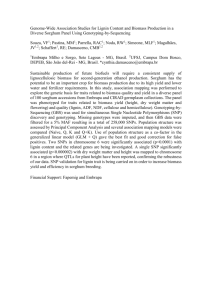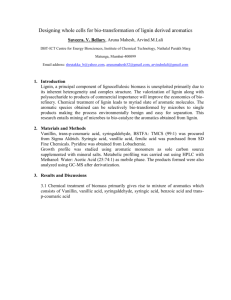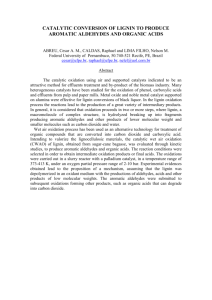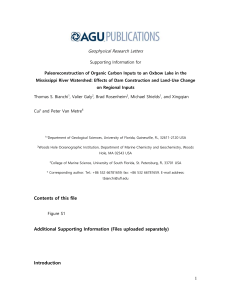Loosening lignin's grip on biofuel production
advertisement
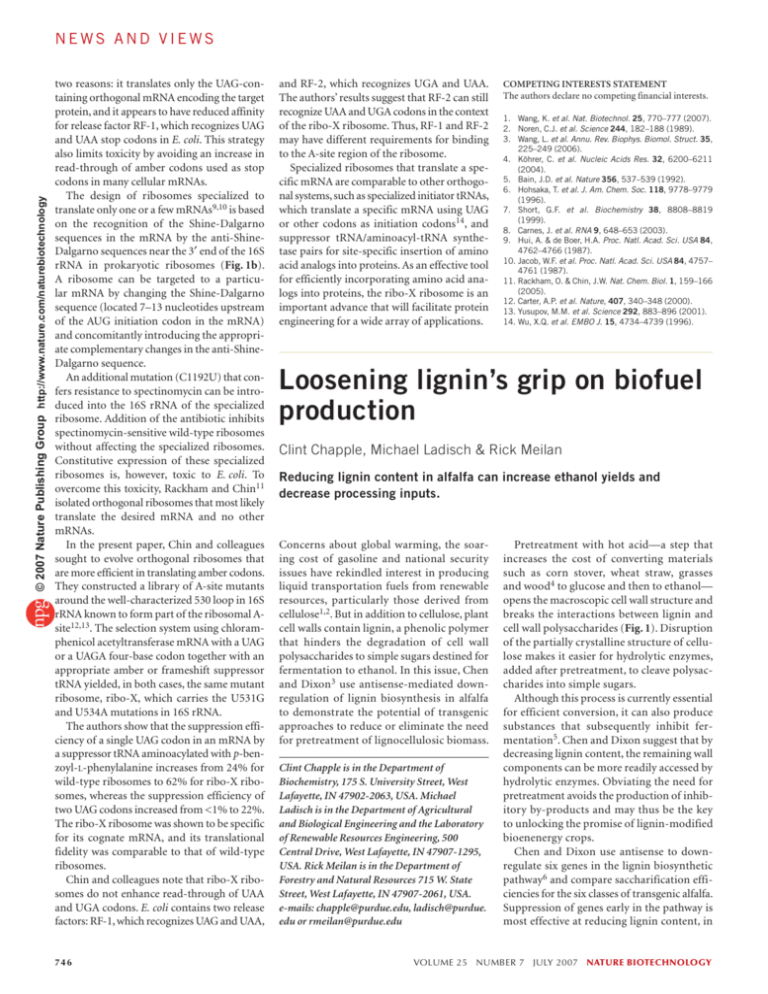
© 2007 Nature Publishing Group http://www.nature.com/naturebiotechnology NEWS AND VIEWS two reasons: it translates only the UAG-containing orthogonal mRNA encoding the target protein, and it appears to have reduced affinity for release factor RF-1, which recognizes UAG and UAA stop codons in E. coli. This strategy also limits toxicity by avoiding an increase in read-through of amber codons used as stop codons in many cellular mRNAs. The design of ribosomes specialized to translate only one or a few mRNAs9,10 is based on the recognition of the Shine-Dalgarno sequences in the mRNA by the anti-ShineDalgarno sequences near the 3′ end of the 16S rRNA in prokaryotic ribosomes (Fig. 1b). A ribosome can be targeted to a particular mRNA by changing the Shine-Dalgarno sequence (located 7–13 nucleotides upstream of the AUG initiation codon in the mRNA) and concomitantly introducing the appropriate complementary changes in the anti-ShineDalgarno sequence. An additional mutation (C1192U) that confers resistance to spectinomycin can be introduced into the 16S rRNA of the specialized ribosome. Addition of the antibiotic inhibits spectinomycin-sensitive wild-type ribosomes without affecting the specialized ribosomes. Constitutive expression of these specialized ribosomes is, however, toxic to E. coli. To overcome this toxicity, Rackham and Chin11 isolated orthogonal ribosomes that most likely translate the desired mRNA and no other mRNAs. In the present paper, Chin and colleagues sought to evolve orthogonal ribosomes that are more efficient in translating amber codons. They constructed a library of A-site mutants around the well-characterized 530 loop in 16S rRNA known to form part of the ribosomal Asite12,13. The selection system using chloramphenicol acetyltransferase mRNA with a UAG or a UAGA four-base codon together with an appropriate amber or frameshift suppressor tRNA yielded, in both cases, the same mutant ribosome, ribo-X, which carries the U531G and U534A mutations in 16S rRNA. The authors show that the suppression efficiency of a single UAG codon in an mRNA by a suppressor tRNA aminoacylated with p-benzoyl-L-phenylalanine increases from 24% for wild-type ribosomes to 62% for ribo-X ribosomes, whereas the suppression efficiency of two UAG codons increased from <1% to 22%. The ribo-X ribosome was shown to be specific for its cognate mRNA, and its translational fidelity was comparable to that of wild-type ribosomes. Chin and colleagues note that ribo-X ribosomes do not enhance read-through of UAA and UGA codons. E. coli contains two release factors: RF-1, which recognizes UAG and UAA, 746 and RF-2, which recognizes UGA and UAA. The authors’ results suggest that RF-2 can still recognize UAA and UGA codons in the context of the ribo-X ribosome. Thus, RF-1 and RF-2 may have different requirements for binding to the A-site region of the ribosome. Specialized ribosomes that translate a specific mRNA are comparable to other orthogonal systems, such as specialized initiator tRNAs, which translate a specific mRNA using UAG or other codons as initiation codons14, and suppressor tRNA/aminoacyl-tRNA synthetase pairs for site-specific insertion of amino acid analogs into proteins. As an effective tool for efficiently incorporating amino acid analogs into proteins, the ribo-X ribosome is an important advance that will facilitate protein engineering for a wide array of applications. COMPETING INTERESTS STATEMENT The authors declare no competing financial interests. 1. Wang, K. et al. Nat. Biotechnol. 25, 770–777 (2007). 2. Noren, C.J. et al. Science 244, 182–188 (1989). 3. Wang, L. et al. Annu. Rev. Biophys. Biomol. Struct. 35, 225–249 (2006). 4. Köhrer, C. et al. Nucleic Acids Res. 32, 6200–6211 (2004). 5. Bain, J.D. et al. Nature 356, 537–539 (1992). 6. Hohsaka, T. et al. J. Am. Chem. Soc. 118, 9778–9779 (1996). 7. Short, G.F. et al. Biochemistry 38, 8808–8819 (1999). 8. Carnes, J. et al. RNA 9, 648–653 (2003). 9. Hui, A. & de Boer, H.A. Proc. Natl. Acad. Sci. USA 84, 4762–4766 (1987). 10. Jacob, W.F. et al. Proc. Natl. Acad. Sci. USA 84, 4757– 4761 (1987). 11. Rackham, O. & Chin, J.W. Nat. Chem. Biol. 1, 159–166 (2005). 12. Carter, A.P. et al. Nature, 407, 340–348 (2000). 13. Yusupov, M.M. et al. Science 292, 883–896 (2001). 14. Wu, X.Q. et al. EMBO J. 15, 4734–4739 (1996). Loosening lignin’s grip on biofuel production Clint Chapple, Michael Ladisch & Rick Meilan Reducing lignin content in alfalfa can increase ethanol yields and decrease processing inputs. Concerns about global warming, the soaring cost of gasoline and national security issues have rekindled interest in producing liquid transportation fuels from renewable resources, particularly those derived from cellulose1,2. But in addition to cellulose, plant cell walls contain lignin, a phenolic polymer that hinders the degradation of cell wall polysaccharides to simple sugars destined for fermentation to ethanol. In this issue, Chen and Dixon3 use antisense-mediated downregulation of lignin biosynthesis in alfalfa to demonstrate the potential of transgenic approaches to reduce or eliminate the need for pretreatment of lignocellulosic biomass. Clint Chapple is in the Department of Biochemistry, 175 S. University Street, West Lafayette, IN 47902-2063, USA. Michael Ladisch is in the Department of Agricultural and Biological Engineering and the Laboratory of Renewable Resources Engineering, 500 Central Drive, West Lafayette, IN 47907-1295, USA. Rick Meilan is in the Department of Forestry and Natural Resources 715 W. State Street, West Lafayette, IN 47907-2061, USA. e-mails: chapple@purdue.edu, ladisch@purdue. edu or rmeilan@purdue.edu Pretreatment with hot acid—a step that increases the cost of converting materials such as corn stover, wheat straw, grasses and wood4 to glucose and then to ethanol— opens the macroscopic cell wall structure and breaks the interactions between lignin and cell wall polysaccharides (Fig. 1). Disruption of the partially crystalline structure of cellulose makes it easier for hydrolytic enzymes, added after pretreatment, to cleave polysaccharides into simple sugars. Although this process is currently essential for efficient conversion, it can also produce substances that subsequently inhibit fermentation5. Chen and Dixon suggest that by decreasing lignin content, the remaining wall components can be more readily accessed by hydrolytic enzymes. Obviating the need for pretreatment avoids the production of inhibitory by-products and may thus be the key to unlocking the promise of lignin-modified bioenenergy crops. Chen and Dixon use antisense to downregulate six genes in the lignin biosynthetic pathway6 and compare saccharification efficiencies for the six classes of transgenic alfalfa. Suppression of genes early in the pathway is most effective at reducing lignin content, in VOLUME 25 NUMBER 7 JULY 2007 NATURE BIOTECHNOLOGY some cases leading to plants that contain less than half the lignin present in wild-type plants. Using a multiple regression model, the authors show that enzymatic hydrolysis and lignin content are inversely correlated. The extent of digestion of untreated stems from two classes of transgenic alfalfa compares favorably with that observed for cellulase-mediated digestion of lignin-free micro-crystalline cellulose that has not been pretreated7. Some plants in which the relative ratio of the three lignin monomers was modestly perturbed were also generated, but as the authors point out, it will be necessary to produce additional lines (e.g., plants with altered lignin composition but the same lignin content, and vice versa) to conclusively address the potential impact of lignin quality on the recalcitrance of biomass to hydrolysis. Although sugarcane and corn have received considerable attention as potential bioenergy crops, there is no doubt that feedstock beyond these sugar- or starch-rich sources Unmodified will be needed to meet the increased demand for ethanol. For the US alone, this is expected to increase from the current annual production of 5.8 billion gallons to an estimated 20 billion gallons within the next ten years. However, it is worth noting that reducing or eliminating the need for pretreatments that make lignocellulose susceptible to attack by hydrolytic enzymes also promises to enhance ethanol yields from sugarcane or corn by enabling sugarcane bagasse or corn stover to be converted to fermentable sugars. Although the work of Chen and Dixon involves basic research, it relates to a critical, applied problem and its success will ultimately be measured against the economics of biofuel production. For example, the enzymes required for biomass hydrolysis are estimated to contribute 15–30 cents per gallon to the cost of ethanol production, and the biomass feedstock itself adds an additional 50–80 cents per gallon, including pretreatment—which adds significantly to the cost of raw material. Pretreatment costs reflect PHE CONALC SINALC Enzymatic digestion Pre CONALC SINALC Enzymatic digestion Fermentation Distillation Transgenic PHE the amount of energy and chemicals that are used, although some savings are realized because effective pretreatment reduces the amount of hydrolytic enzymes needed. For example, for every gram of biomass in their pretreatment, Chen and Dixon used about 0.13 g acid, which at industrial levels costs 3.5 cents per pound. If their approach can be translated from the lab to the field and pretreatment can be eliminated, the savings on acid alone would be about 5.5 pounds of acid or 20 cents per gallon of ethanol, with elimination of other costs associated with pretreatment doubling or tripling these savings. Even if pretreatment is still needed, attendant capital and reagent-disposal costs would be reduced. This work provides only the first glimpse of what can be done to improve the quality of crops for biofuel production. Lignin biosynthesis has been relatively amenable to study: the intermediates of the pathway are few in number, readily detectable by conventional analytical methods, and in many Lignin Pretreatment Lignin Pre nt me at tre tre atm en t Antisense constructs Enzymatic digestion Fermentation Distillation Kim Caesar © 2007 Nature Publishing Group http://www.nature.com/naturebiotechnology NEWS AND VIEWS Figure 1 Reduced lignin content can increase yields of fermentable sugars after pretreatment of plant biomass with hot acid and can also reduce or eliminate the need for this step. Under standard processing conditions, saccharification efficiencies of certain alfalfa antisense lines with reduced lignin content are double those of unmodified material. Perhaps of greater relevance is the demonstration that saccharification efficiencies of untreated transgenic biomass are comparable to that of unmodified biomass subjected to pretreatment. PHE, phenylalanine; CONALC, coniferyl alcohol; SINALC, sinapyl alcohol. NATURE BIOTECHNOLOGY VOLUME 25 NUMBER 7 JULY 2007 747 © 2007 Nature Publishing Group http://www.nature.com/naturebiotechnology NEWS AND VIEWS tissues, devoted almost exclusively to the synthesis of lignin. Most importantly, once lignin precursors are activated to their corresponding free radicals by peroxidases or laccases, their polymerization is not protein- or template-directed8. As a result, lignin composition is highly plastic and amenable to manipulation. In contrast, the tools for manipulating the polysaccharide components of the plant cell wall are just beginning to be assembed9. Considering the dramatic results obtained by altering expression of lignin pathway genes, we can expect that future efforts directed at manipulation of cellulose, hemicellulose, and pectin biosynthesis and deposition will have similarly valuable impacts on cell wall chemistry and architecture, and may have synergistic impacts with lignin modification strategies. In addition to increasing accessibility to cell wall polymers in bioenergy crops, there are other critical issues that need to be addressed to meet the needs of the rapidly evolving biofuel industry. For example, antisense-mediated reductions in lignin content have been shown to reduce biomass by up to 40% (Fig. 1). Although improvements in fermentable sugar production might compensate for these decreases in biomass, it is clear that economically viable production of biofuels will require sustained agronomic yields in excess of ten tons biomass per acre per year1. Further, given that the xylosecontaining hemicellulose fraction may be more accessible in lignin-modified plants, advances in microbial engineering will be more important than ever10, so that other liberated sugars can be used during fermentation. Finally, not only will it be necessary to engineer or breed insect and disease resistance into bioenergy crops, it will be essential to determine whether cell wall manipulations have compromised the plant’s structural integrity or susceptibility to pests and pathogens. The concerted efforts of plant biologists, microbiologists, biochemists, engineers, agronomists and economists will be needed to devise the optimal solution to trade-offs between biomass quality and yield, conversion efficiency and sustainability. COMPETING INTERESTS STATEMENT The authors declare no competing financial interests. 1. US Department of Agriculture and US Department of Energy (DOE). Biomass as Feedstock for a Bioenergy and Bioproducts Industry: The Technical Feasibility of a Billion-Ton Annual Supply (US DOE, Oak Ridge, TN and US Department of Commerce, Springfield, VA, 2005). <http://www1.eere.energy.gov/biomass/ pdfs/final_billionton_vision_report2.pdf> 2. US Department of Energy. Breaking the Biological 748 Barriers to Cellulosic Ethanol: A Joint Research Agenda. A Research Roadmap Resulting from the Biomass to Biofuels Workshop, Rockville, MD, December 7–9, 2005 <http://genomicsgtl.energy. gov/biofuels/b2bworkshop.shtml> 3. Chen, F. & Dixon, R.A. Nat. Biotechnol. 25, 759–761 (2007). 4. Mosier, N. et al. Bioresour. Technol. 96, 673–686 (2005). 5. Keating, J.D., Panganiban, C. & Mansfield, S.D. Biotechnol. Bioeng. 93, 1196–1206 (2006). 6. Chen, F. et al. Plant J. 48, 113–124 (2006). 7. Ladisch, M.R. et al. Proceedings of the Ninth International Biotechnology Symposium, Washington, DC (August 20, 1992) (American Chemical Society, Washington, 1992). 8. Boerjan, W., Ralph, J. & Baucher, M. Annu. Rev. Plant Biol. 54, 519–546 (2003). 9. Somerville, C. et al. Science 306, 2206–2211 (2004). 10. Jeffries, T.W. & Jin, Y.S. Appl. Microbiol. Biotechnol. 63, 495–509 (2004). Human embryonic stem cells flock together M William Lensch & George Q Daley An international survey of human embryonic stem cell lines provides a benchmark for comparing results across laboratories. How similar are the many human embryonic stem (hES) cell lines being studied in laboratories around the world? In the absence of standardized methods for deriving, culturing and characterizing hES cells, the International Stem Cell Initiative (ISCI) has sought to answer this question with an ambitious project “to carry out a comparative study of a large and diverse set of hES cell lines derived and maintained in different laboratories worldwide”1. The results of the first phase of this project are reported in this issue1. The study shows that despite unique genetic backgrounds, derivation in various labs with different techniques and maintenance under different culture and passage conditions, hES lines manifest a remarkable degree of phenotypic similarity and harbor a common set of markers that represent reliable indicators of hES cell identity. More generally, this report stands as an admirable demonstration of international collaborative efforts in hES cell research that aim to promote deeper scientific understanding and advance human health. The ISCI study covers 59 different hES cell lines maintained in 17 laboratories scattered across 11 countries. Although not the M. William Lensch and George Q. Daley are in the Division of Hematology/Oncology, Children’s Hospital Boston, Karp Building, 7th Floor 300 Longwood Ave. Boston, MA 02115 and Department of Biological Chemistry and Molecular Pharmacology, Harvard Medical School, Boston, Massachusetts and Harvard Stem Cell Institute, Cambridge, Massachusetts, USA. e-mail: George.Daley@childrens.harvard.edu first comparative study of hES cell lines2, it is the largest cross-sectional analysis to date. Previously, a small group of scientists proposed a number of defining criteria for assessing hES cells that followed from literature reports on a small number of lines3. The ISCI study provides comparative data on a sample population that is large enough to substantiate the proposed standards. It also offers reassurance that hES cells flock together with other hES cells no matter where on the planet they are being studied. The ISCI encouraged participating investigators to use common culture conditions and to perform characterizations with reagents from common lots, although inevitably (and informatively) there were differences in the manner in which cell lines were handled. In some instances, specimens were directed to a centralized laboratory for analysis. The fivepart comparison analyzed surface antigen profiles, gene expression, genomic imprinting, the microbiological status of all lines and feeder cells, and formation of teratoma-like xenografts in immunodeficient mice (Fig. 1). The study documented uniform expression of several surface antigens (SSEA3, SSEA4, TRA-1-60 and TRA-1-81, among others) and a high degree of correlation of gene expression for NANOG, POU5F1/OCT4, TDGF, DNMT3B, GABRB3 and GDF3. The authors conclude that these antigens and genes represent a core set of markers that define hES cells. Assessment of the cells’ epigenetic features also showed a great deal of uniformity: most imprinted gene loci, which are typically transcribed from either the maternal or paternal VOLUME 25 NUMBER 7 JULY 2007 NATURE BIOTECHNOLOGY
